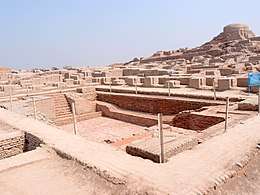Public bathing
Public baths originated from a communal need for cleanliness at a time when most people did not have access to private bathing facilities. The term "public" is not completely accurate, as some types of public baths are restricted depending on membership, gender, religious affiliation, or other reasons. As societies have changed, the need for public baths has reduced: dwellings now have their own private bathroom. Public baths have also become incorporated into the social system as meeting places. As the title suggests, public bathing does not refer only to bathing. In ancient times public bathing included saunas, massages and relaxation therapies, comparable to today's spas.
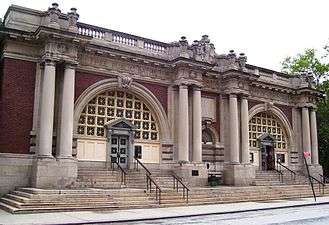
History
Ancient Greece
In The Book of the Bath, Françoise de Bonneville wrote, "The history of public baths begins in Greece in the sixth century B.C.," where men and women washed in basins near places of exercise, physical and intellectual. Later gymnasia had indoor basins set overhead, the open maws of marble lions offering showers, and circular pools with tiers of steps for lounging.
Bathing was ritualized, becoming an art – of cleansing sands, hot water, hot air in dark vaulted "vapor baths", a cooling plunge, a rubdown with aromatic oils. Cities all over Ancient Greece honored sites where "young ephebes stood and splashed water over their bodies."
Indonesia
Traditionally in Indonesia, bathing is almost always "public", in the sense that people might converge in riverbanks, pools or watersprings either for bathing or washing laundry. However, for modesty purposes, some sections of riverbanks apply sex segregation. Bathing completely naked is quite uncommon, as people might still use kain jarik (usually batik clothes or sarong) wrapped around their body to cover their genitals during bathing. More modest bathing springs might use weaved bamboo partitions for privacy. This is still common practice in villages and rural areas in Indonesia.
The 8th-century complex of Ratu Boko contains a petirtaan or bathing pools structure enclosed within walled compound.[1] This suggests that other than bathing in riverbanks or springs, people of ancient Java of Medang Kingdom developed a bathing pool, although it was not actually "public", since the pool was believed to be reserved for royalties or people residing in this compound. The 14th-century Majapahit city of Trowulan, contains several bathing structures, such as Candi Tikus bathing pool, believed to be a royal bathing pool, and also Segaran reservoir or large public pool.[2]
The Hindu-majority island of Bali contains several public bathing pools, some dated from the 9th century such as Goa Gajah. A notable public bathing pool is Tirta Empul, which actually more linked to Balinese Hinduism cleansing ritual than recreation of sanitation purpose.[3] The bubbling water of is the main source of Pakerisan river.
Indus Valley Civilization
Some of the earliest public baths are found in the ruins in of the Indus Valley Civilization. According to John Keay, the "Great Bath" of Mohenjo Daro in present-day Pakistan was the size of 'a modest municipal swimming pool', complete with stairs leading down to the water at each one of its ends.[4]
The bath is housed inside a larger—more elaborate—building and was used for public bathing.[4] The Great Bath and the house of the priest suggest that the Indus had a religion.
Japan
The origin of Japanese bathing is Misogi, ritual purification with water.[5] After Japan imported Buddhist culture, many temples had saunas, which were available for anyone to use for free.
In the Heian period, houses of prominent families, such as the families of court nobles or samurai, had baths. The bath had lost its religious significance and instead became leisure. Misogi became Gyōzui, to bathe in a shallow wooden tub.[6]
In the 17th century, the first European visitors to Japan recorded the habit of daily baths in sexually mixed groups.[5] Before the mid-19th century, when Western influence increased, nude communal bathing for men, women, and children at the local unisex public bath, or sentō, was a daily fact of life.
In contemporary times, many, but not all administrative regions forbid nude mixed gender public baths, with exceptions for children under a certain age when accompanied by parents. Public baths using water from onsen (hot springs) are particularly popular. Towns with hot springs are destination resorts, which are visited daily by the locals and people from other, neighboring towns.
Ottoman Empire
Public baths were widely used throughout the Ottoman Empire. The baths had both a religious and popular origin, deriving from the Islamic ablution ritual (wudu) and the use of steamrooms by the Turks. The Turkish bath, known as hamam, was considered a place for social gatherings in Turkish culture. The process of hamam is very similar to that of Roman bathing.[7]
Roman Empire
The first public thermae of 19 BC had a rotunda 25 metres across, circled by small rooms, set in a park with artificial river and pool. By AD 300 the Baths of Diocletian would cover 140,000 square metres (1,500,000 sq ft), its soaring granite and porphyry sheltering 3,000 bathers a day. Roman baths became "something like a cross between an aquacentre and a theme park", with pools, game rooms, gardens, even libraries and theatres. One of the most famous public bath sites is Aquae Sulis in Bath, England.
Dr. Garrett G Fagan, a professor at Pennsylvania State University, described public bathing as a "social event" for the Romans in his book Bathing in Public in the Roman World. He also states that "In Western Europe only the Finns still practice a truly public bathing habit."[8][9]
Modern public bathing
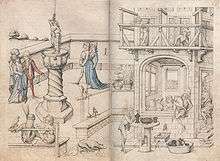
Despite the denunciation of the mixed bathing style of Roman pools by early Christian clergy, as well as the pagan custom of women naked bathing in front of men, this did not stop the Church from urging its followers to go to public baths for bathing,[10] which contributed to hygiene and good health according to the Church Father, Clement of Alexandria. The Church built public bathing facilities that were separate for both sexes near monasteries and pilgrimage sites; also, the popes situated baths within church basilicas and monasteries since the early Middle Ages.[11] Pope Gregory the Great urged his followers on value of bathing as a bodily need.[12]
Roman style public baths were introduced on a limited scale by returning crusaders in the 11th and 12th centuries, who had enjoyed warm baths in the Middle East. These, however, rapidly degenerated into brothels or at least the reputation as such and were closed down at various times. For instance, in England during the reign of Henry II, bath houses, called bagnios from the Italian word for bath, were set up in Southwark on the river Thames. They were all officially closed down by Henry VIII in 1546 due to their negative reputation.
A notable exception to this trend was in Finland and Scandinavia, where the sauna remained a popular phenomenon, even expanding during the Reformation period, when European bath houses were being destroyed. Finnish saunas remain an integral and ancient part of the way of life there. They are found on the lake shore, in private apartments, corporate headquarters, at the Parliament House and even at the depth of 1,400 metres (4,600 ft) in Pyhäsalmi Mine. The sauna is an important part of the national identity[13] and those who have the opportunity usually take a sauna at least once a week.[14]
The building of public baths in the United States began in the 1890s. Notable constructions of the period include Bathhouse Row[15] in Arkansas, and Asser Levy Public Baths in New York City. Public baths were created to improve health and sanitary condition of the public before personal baths became commonplace.
British Empire

The first modern public baths were opened in Liverpool in 1829. The first known warm fresh-water public wash house was opened in May 1842.[16][17]
The popularity of wash-houses was spurred by the newspaper interest in Kitty Wilkinson, an Irish immigrant "wife of a labourer" who became known as the Saint of the Slums.[18] In 1832, during a cholera epidemic, Wilkinson took the initiative to offer the use of her house and yard to neighbours to wash their clothes, at a charge of a penny per week,[16] and showed them how to use a chloride of lime (bleach) to get them clean. She was supported by the District Provident Society and William Rathbone. In 1842 Wilkinson was appointed baths superintendent.[19][20]
In Birmingham, around ten private baths were available in the 1830s. Whilst the dimensions of the baths were small, they provided a range of services.[21] A major proprietor of bath houses in Birmingham was a Mr. Monro who had had premises in Lady Well and Snow Hill.[22] Private baths were advertised as having healing qualities and being able to cure people of diabetes, gout and all skin diseases, amongst others.[22] On 19 November 1844, it was decided that the working class members of society should have the opportunity to access baths, in an attempt to address the health problems of the public. On 22 April and 23 April 1845, two lectures were delivered in the town hall urging the provision of public baths in Birmingham and other towns and cities.
After a period of campaigning by many committees, the Public Baths and Wash-houses Act received royal assent on 26 August 1846. The Act empowered local authorities across the country to incur expenditure in constructing public swimming baths out of its own funds.[23]
The first London public baths was opened at Goulston Square, Whitechapel, in 1847 with the Prince consort laying the foundation stone.[24][25]
The introduction of bath houses into British culture was a response to the public's desire for increased sanitary conditions, and by 1915 most towns in Britain had at least one.[26]
Hot Baths

Traditional Turkish baths (a variant of the Roman bath) were introduced to Britain by David Urquhart, diplomat and sometime Member of Parliament for Stafford, who for political and personal reasons wished to popularize Turkish culture. In 1850 he wrote The Pillars of Hercules, a book about his travels in 1848 through Spain and Morocco. He described the system of dry hot-air baths used there and in the Ottoman Empire which had changed little since Roman times. In 1856 Richard Barter read Urquhart's book and worked with him to construct a bath. They opened the first modern hot water bath at St Ann's Hydropathic Establishment near Blarney, County Cork, Ireland.[27] The original baths were used for individual washing and men-only swimming. It was not until 1914 that family bathing was allowed.[28]
The following year, the first public bath of its type to be built in mainland Britain since Roman times was opened in Manchester, and the idea spread rapidly. It reached London in July 1860, when Roger Evans, a member of one of Urquhart's Foreign Affairs Committees, opened a Turkish bath at 5 Bell Street, near Marble Arch. During the following 150 years, over 600 Turkish baths opened in Britain, including those built by municipal authorities as part of swimming pool complexes, taking advantage of the fact that water-heating boilers were already on site.
Similar baths opened in other parts of the British Empire. Dr. John Le Gay Brereton opened a Turkish bath in Sydney, Australia in 1859, Canada had one by 1869, and the first in New Zealand was opened in 1874. Urquhart's influence was also felt outside the Empire when in 1861, Dr Charles H Shepard opened the first Turkish baths in the United States at 63 Columbia Street, Brooklyn Heights, New York, most probably on 3 October 1863.[29][30]
Russia
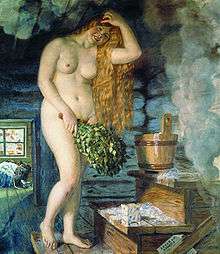
Washing and thermal body treatments with steam and accessories such as a bunch of birch branches has been traditionally carried out in banyas. This traditions were born in rural areas, Russia being a spacious country with farming population dominating until World War II. Farmers did not have inside their log cabins running water supply and hot bathtubs for washing their bodies, so they either used for their washing heat and space inside their Russian stoves or built from logs, like the cottage itself, a one-family banya bath outhouse behind their dwelling on the family's land plot. It was usually a smallish wooden cabin with a low entrance and no more than one small window to keep heat inside. Traditionally, the family washed their bodies completely once a week before the day of the Bible-prescribed rest (Sunday) as having a (steam) bath meant having to get and bring in a considerable amount of firewood and water and spending time off other farm work heating the bathhouse.
With the growth of Russian big cities since the 18th century, public baths were opened in them and then back in villages. While the richer urban circles could afford having an individual bathroom with a bathtub in their apartments (since the late 19th century with running water), the lower classes necessarily used public steambaths – special big buildings which were equipped with developed side catering services enjoyed by the merchants with farming background.
Since the first half of the 20th century running unheated drinking water supply has been made available virtually to all inhabitants of multi-storey apartment buildings in cities, but if such dwellings were built during the 1930s and not updated later, they do not have hot running water (except for central heating) or space to accommodate a bathtub, plumbing facilities being limited in them only to a kitchen sink and a small toilet room with a toilet seat. Thus the dwellers of such apartments, on a par with those living in the part of pre-1917-built blocks of flats which had not undergone cardinal renovation, would have no choice but to use public bathhouses.
Since the 1950s in cities, towns and many rural areas more comfortable dwelling became a nationally required standard, and almost all apartments are designed with both cold and hot water supply, and a bathroom with a bathtub, but a percentage of people living in them still go to public steam baths for health treatments with steam, tree branches, aromatic oils.
Gallery
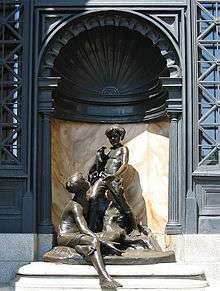 Alfred Laliberté's Les petits Baigneurs, 1915 restored 1992 at Maisonneuve public baths, Montreal, Quebec
Alfred Laliberté's Les petits Baigneurs, 1915 restored 1992 at Maisonneuve public baths, Montreal, Quebec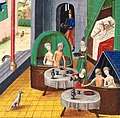 Bathing in 1450
Bathing in 1450 Bathing in 1568
Bathing in 1568 A woman bathing is spied upon through a window
A woman bathing is spied upon through a window Ancient Ruins Used as Public Baths by Hubert Robert (1798)
Ancient Ruins Used as Public Baths by Hubert Robert (1798)
See also
- Bathing
- Steam shower
- Water park
- By culture
- Gymnasium (ancient Greece)
- Banya – Russian
- Sauna – Finnish
- Hammam – Turkish
- Hanjeungmak & Jjimjilbang – Korean
- Bathing culture in Yangzhou – China
- Sweat lodge – Native American
References
- "The Majestic Beauty of the Ratu Boko Palace ruins". Wonderful Indonesia. Archived from the original on 2014-06-25. Retrieved 2014-06-23.
- Sita W. Dewi (9 April 2013). "Tracing the glory of Majapahit". The Jakarta Post. Retrieved 5 February 2015.
- "Pura Tirta Empul". Burari Bali. Retrieved 5 October 2014.
- Keay, John (2001). India: A History. Grove Press. pp. 13–14. ISBN 0-8021-3797-0.
- Clark, Scott (1994). Clark – 1994. ISBN 9780824816575.
backcover Misogi
- Clark, Scott (1994). Clark – 1994. p. 36. ISBN 9780824816575.
Gyōzui
- "About Bath Houses, Turkish Baths and Sauna Culture and Bath Resources". Aquariussauna.com. Retrieved 2014-05-21.
- "Professor Garrett G. Fagan – Audio & Video Lectures". The Great Courses. Retrieved 2014-05-21.
- Fagan, Garrett G. (2002). Bathing in Public in the Roman World. ISBN 0472088653.
- Warsh, Cheryl Krasnick (2006). Children's Health Issues in Historical Perspective. Veronica Strong-Boag. Wilfrid Laurier Univ. Press. p. 315. ISBN 978-0-88920-912-1.
... Thus bathing also was considered a part of good health practice. For example, Tertullian attended the baths and believed them hygienic. Clement of Alexandria, while condemning excesses, had given guidelines for Christian] who wished to attend the baths ...
- Thurlkill, Mary (2016). Sacred Scents in Early Christianity and Islam: Studies in Body and Religion. Rowman & Littlefield. pp. 6–11. ISBN 978-0-7391-7453-1.
... Clement of Alexandria (d. c. 215 CE) allowed that bathing contributed to good health and hygiene ... Christian skeptics could not easily dissuade the baths' practical popularity, however; popes continued to build baths situated within church basilicas and monasteries throughout the early medieval period ...
- Squatriti, Paolo (2002). Water and Society in Early Medieval Italy, AD 400-1000, Parti 400–1000. Cambridge University Press. p. 54. ISBN 978-0-521-52206-9.
... but baths were normally considered therapeutic until the days of Gregory the Great, who understood virtuous bathing to be bathing "on account of the needs of body" ...
- Valtakari, P. "Finnish Sauna Culture – Not Just a Cliché". The Finnish Sauna Society.
- Korhonen, N (April 1998). "The sauna – a sacred place". Universitas Helsingiensis. Helsinki: Helsinki University.
- "FORDYCE Bathhouse General History". asms.k12.ar.us. Archived from the original on 2008-02-28. Retrieved 2008-03-24.
- Ashpitel, Arthur (1851), Observations on baths and wash-houses, p. 2–14, JSTOR 60239734, OCLC 501833155
- Metcalfe, Richard (1877), Sanitas Sanitatum et Omnia Sanitas, 1, Co-operative printing company, p. 3
- "'Slum Saint' honoured with statue". BBC News. 4 February 2010.
- Wohl, Anthony S. (1984), Endangered lives: public health in Victorian Britain, Taylor & Francis, p. 73, ISBN 978-0-416-37950-1
- Rathbone, Herbert R. (1927), Memoir of Kitty Wilkinson of Liverpool, 1786-1860: with a short account of Thomas Wilkinson, her husband, H. Young & Sons
- West, William (1830). Topography of Warwickshire.
- "Private Bath Advertisements". The Birmingham Journal. 1851-05-17.
- "Baths and Wash-Houses". The Times. 1846-07-22. p. 6.
Yesterday the bill, as amended by the committee, for promoting the voluntary establishment in boroughs and parishes in England and Wales of public baths and wash-houses was printed.
- "Classified Advertising". The Times]. 1847-07-26. p. 1.
Model Public Baths, Goulston-square, Whitechapel. The BATHS for men and boys are now OPEN from 5 in the morning till 10 at night. Charges – first-class (two towels), cold bath 5d., warm bath 6d.; second-class (one towel), cold bath 1d, warm bath 2d. Every bath is in a private room.
- Metcalfe, Richard (1877), Sanitas Sanitatum et Omnia Sanitas, 1, Co-operative printing company, p. 7
- Sally Sheard* (2014-05-02). "Profit is a Dirty Word: The Development of Public Baths and Wash-houses in Britain 1847–1915 – SHEARD 13 (1): 63 – Social History of Medicine". Shm.oxfordjournals.org. Retrieved 2014-05-21.
- Shifrin, Malcolm (3 October 2008), "St Ann's Hydropathic Establishment, Blarney, Co. Cork", Victorian Turkish Baths: Their origin, development, and gradual decline, retrieved 12 December 2009
- "Port Cities: – Liverpool baths and wash houses timeline, 1789–1952". Archived from the original on 2004-11-15.
- "Advertisement". The Brooklyn Daily Eagle. 1863-10-03.
- To Philadelphians on behalf of the Natatorium & Physical Institute. 1860. p. 11. Retrieved 2012-12-04.
Bibliography
- Clark, Scott (1994). Japan, a view from the bath. University of Hawaii Press. ISBN 0-8248-1657-9.CS1 maint: ref=harv (link)
External links
| Wikimedia Commons has media related to Baths. |
- "Tales of Toronto's first Jewish shvitz".
- "A guide to public baths in Japan". SentoGuide.
- "Public bath houses in Kyoto". Kyoto Baths.
- "The oldest public bath in Kyoto". Funaoka Onsen.
